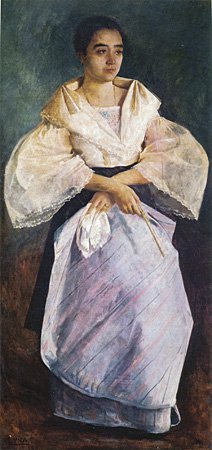Cultural Center of the Philippines
ENCYCLOPEDIA OF
PHILIPPINE ART
La Bulaqueña
(The Lass from Bulacan) / 1895 / Oil on canvas / 185 x 87 cm / Artist: Juan Luna / National Museum of the Philippines Collection
La Bulaqueña by Luna is a masterpiece of Philippine turn-of-the-century portraiture. The subject of the work is a comely Filipina from an elite provincial family. She is depicted full figure in the formal dress of the time.
La Bulaqueña has a naturalness rarely found in portraits of the same period. Its subject is shown casually holding her floor-length train over her black tapis or overskirt. Although she still carries an ivory fan and lace handkerchief, the obligatory props of 19th-century female portraiture, she does so with unique informality. Luna painted her at an oblique angle to keep the stiffness out of her pose. Unlike his contemporaries who were fond of filling portrait backgrounds with family heirlooms and religious images, Luna used a simple blue-green background for his subject’s face and form.
The portrait’s gracefully curved lines provide the illusion of movement from the subject’s lace-edged sleeves down her crossed arms toward the stripes of her skirt. The visual movement then reverts toward her face. Although not strikingly beautiful, the subject’s face is an interesting one; her heavy brows, deep-set eyes and pert nose are set in a pensive, almost sad expression.
Luna’s rendition of textural illusion is noteworthy in the portrait. The transparent jusi of the blouse and the thick weave of skirt material appear so true to life they can almost be felt by the viewer. The delicate lace edges of the billowing sleeves and pañuelo or kerchief even shimmer in the light.
The lady in the picture was Emiliana Yriarte Trinidad (b. 4 Jan 1878 d. 22 Mar 1971). She was less than 17 years old when she posed for the painting, which Luna started in Nov 1895 and finished in the first months of 1896. The painting was sold to the National Museum during World War II for 200 in Japanese military notes.
Written by Noel Valdellon, N. Ferrer, and Santiago A. Pilar
